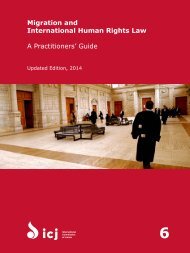You also want an ePaper? Increase the reach of your titles
YUMPU automatically turns print PDFs into web optimized ePapers that Google loves.
50 — EASO Country of Origin Information report — South and Central <strong>Somalia</strong> — Country overview<br />
of the occupational groups are often challenged by majority clans, sometimes successfully. Given the limited land<br />
available, occupational groups are not able to feed bigger cattle droves. Furthermore, they are usually restricted<br />
to their traditional jobs and have no access to work in the public service ( 341 ).<br />
After <strong>Somalia</strong>’s independence, and especially during the Socialist regime of Siyaad Barre, clanism was officially<br />
abrogated, which improved the situation of the groups at the lowest levels of society. Some minority members<br />
ascended to prestigious positions in government, administration and the military. The abolition of clans was only<br />
theoretical, however, and after the collapse of the Somali state in 1991, they resurfaced. Thus, the growing influence<br />
of the clans weakened the position of minorities in society, which also suffered disproportionately from fighting in<br />
their regions ( 342 ). Lacking clan protection, they had nowhere to flee within <strong>Somalia</strong>, forcing many of them to seek<br />
refuge in neighbouring countries ( 343 ). They also lost their monopoly on traditional tasks ( 344 ).<br />
Al‐Shabaab theoretically (but not consequently) abolished clanism, which again put minorities in some regions in<br />
a somewhat better position than before, and led some of them to initially support Al‐Shabaab. Since the decline<br />
of Al‐Shabaab’s power, this support is dropping again. In areas from which Al‐Shabaab has withdrawn, minority<br />
members sometimes face repercussion for having supported Al‐Shabaab ( 345 ). For more information on this, see<br />
also section 3.5.9.<br />
2.2.4 Client relationships of minority groups<br />
The position of a group within Somali society is mainly defined by its ability to defend itself. As small and poor<br />
groups, minorities usually are in no position to defend and enforce their rights against a majority clan. Therefore,<br />
they often enter a long‐term client relation with a majority clan according to Somali customary law (xeer), in which<br />
protection, conflict resolution and marriage rules are regulated ( 346 ). This client relation is known as gaashaanbuur<br />
(‘pile of shields’). There are different degrees of gaashaanbuur depending on the status of the associated group:<br />
neighbour, appendage, followers or pretenders (sheegat). The latter is the usual status of occupational groups,<br />
because it allows them to assume the lineage affiliation of their protectors. Sometimes, the majority clan even pays<br />
mag for the protected ( 347 ).<br />
Gaashaanbuur contractors do not become fully‐fledged members of their protector clan. Such alliances are voluntary<br />
and can be dissolved by both sides. Consequently, the minorities are no ‘bondsmen’, but are rather to be considered<br />
( 341 ) Tiwald, A., Die Parias <strong>Somalia</strong>s: Ständische Berufskasten als Basis sozialer Diskriminierung, Österreichischer Integrationsfonds, December 2010 (http://<br />
www.integrationsfonds.at/laenderinformation/diepariassomalias) accessed 10 June 2014, p. 13; Ambroso, G., Pastoral society and transnational refugees:<br />
population movements in Somaliland and eastern Ethiopia 1988-2000, August 2002 (http://www.unhcr.org/3d5d0f3a4.html) accessed 10 June 2014, p. 30.<br />
( 342 ) Tiwald, A., Die Parias <strong>Somalia</strong>s: Ständische Berufskasten als Basis sozialer Diskriminierung, Österreichischer Integrationsfonds, December 2010 (http://<br />
www.integrationsfonds.at/laenderinformation/diepariassomalias) accessed 10 June 2014, p. 32-33; Landinfo, Respons <strong>Somalia</strong>: Yrkes- od lavstatusgrupper,<br />
25 July 2013 (http://landinfo.no/asset/2460/1/2460_1.pdf) accessed 10 June 2014, p. 5-6; BAMF, Minderheiten in <strong>Somalia</strong>, July 2010 (https://milo.bamf.de/<br />
milop/livelink.exe/fetch/2000/702450/683266/693991/697672/697677/6029534/13604856/13565580/Deutschland___Bundesamt_f%C3%BCr_Migration_<br />
und_Fl%C3%BCchtlinge,_Minderheiten_in_<strong>Somalia</strong>,_Juli_2010.pdfnodeid=13904432&vernum=-2) accessed 10 June 2014, p. 18; Höhne, M. V., ‘Continuities<br />
and changes regarding minorities in <strong>Somalia</strong>’, Ethnic and Racial Studies, Routledge, 2014, p. 5-10.<br />
( 343 ) Landinfo, Repons <strong>Somalia</strong>: Sårbarhet – minoritetsgrupper, svake klaner og utsatte enkeltpersoner i sør, 8 May 2012 (http://landinfo.no/asset/2068/1/2068_1.<br />
pdf) accessed 10 June 2014, p. 3; Höhne, M. V., ‘Continuities and changes regarding minorities in <strong>Somalia</strong>’, Ethnic and Racial Studies, Routledge, 2014, p. 6-7.<br />
( 344 ) Minority Rights Group International, No redress: <strong>Somalia</strong>’s forgotten minorities, 31 January 2010 (http://www.minorityrights.org/lid=10370) accessed<br />
10 June 2014, p. 2.<br />
( 345 ) Landinfo, Repons <strong>Somalia</strong>: Sårbarhet – minoritetsgrupper, svake klaner og utsatte enkeltpersoner i sør, 8 May 2012 (http://landinfo.no/asset/2068/1/2068_1.<br />
pdf) accessed 10 June 2014, p. 2; UN Human Rights Council, <strong>Report</strong> of the independent expert on the situation of human rights in <strong>Somalia</strong>, Shamsul Bari,<br />
8 March 2010 (http://reliefweb.int/sites/reliefweb.int/files/resources/8196336C6C0EA522492576E3001A7B8C‐Full_<strong>Report</strong>.pdf) accessed 10 June 2014,<br />
p. 13; Höhne, M. V., ‘Continuities and changes regarding minorities in <strong>Somalia</strong>’, Ethnic and Racial Studies, Routledge, 2014, p. 9.<br />
( 346 ) Tiwald, A., Die Parias <strong>Somalia</strong>s: Ständische Berufskasten als Basis sozialer Diskriminierung, Österreichischer Integrationsfonds, December 2010 (http://www.<br />
integrationsfonds.at/laenderinformation/diepariassomalias) accessed 10 June 2014, p. 9-11; Gundel, J., The predicament of the ‚Oday‘. The role of traditional<br />
structures in security, rights, law and development in <strong>Somalia</strong>, November 2006 (http://logcluster.org/sites/default/files/documents/Gundel_The%2520role<br />
%2520of%2520traditional%2520structures.pdf) accessed 10 June 2014, p. 51-52; Lewis, I. M., Blood and bone. The call of kinship in Somali Society, The Red<br />
Sea Press, Lawrenceville, 1994, p. 126; Landinfo, Respons <strong>Somalia</strong>: Yrkes- od lavstatusgrupper, 25 July 2013 (http://landinfo.no/asset/2460/1/2460_1.pdf)<br />
accessed 10 June 2014, p. 5; Minority Rights Group International, No redress: <strong>Somalia</strong>’s forgotten minorities, 31 January 2010 (http://www.minorityrights.<br />
org/lid=10370) accessed 10 June 2014, p. 9.<br />
( 347 ) Lewis, I.M., Peoples of the Horn of Africa: Somali, Afar and Saho, International African Institute, London, 1955, p. 149; ACCORD, Clans in <strong>Somalia</strong>. <strong>Report</strong> on<br />
a Lecture by Joakim Gundel, December 2009 (http://www.ecoi.net/file_upload/90_1261130976_accord‐report‐clans‐in‐somalia‐revised‐edition-20091215.<br />
pdf) accessed 10 June 2014, p. 22.



